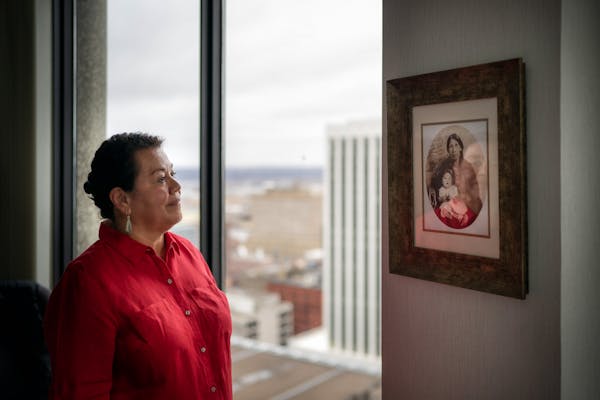The push to solve hundreds of cases of missing and murdered Indigenous Minnesotans hit a milestone last year with the opening of a first-in-the-nation office charged with systemically trying to fix the problem.
Now, Native American legislators and community leaders are trying to make sure the office has the resources it needs to tackle the task ahead — one that's been complicated by decades of inconsistent data and a lack of mainstream attention.
"The work is never going to be done," state Sen. Mary Kunesh, DFL-New Brighton, said Tuesday in front of a packed gymnasium before hundreds went out in the rain for the annual march for Missing and Murdered Indigenous Relatives. "At the Legislature we are fighting so hard to ensure that we have the resources that we need in order to continue this work."
Gov. Tim Walz is pitching more funding to add two full-time staffers to the Missing and Murdered Indigenous Relatives Office to help review cases and work with families trying to find their missing loved ones. A proposal moving at the Legislature would create special license plates to help fund the office's work into the future, while another aims to establish a reward fund to encourage tips on cases that have gone cold, some for decades.
"Who goes out looking for you? We do. Who funds that effort? We do out of our own pockets," said Rep. Alicia Kozlowski, DFL-Duluth, who is Ojibwe. "We have to get that money back into our communities."
Hundreds gathered Tuesday in Minneapolis for the first time since the pandemic to march for those missing relatives. They called out their names and carried signs bearing their faces as they advanced through the steady rainfall.
Native American women and girls comprise only 1% of the state's population but made up 8% of all murdered women and girls in Minnesota from 2010 through 2018. Between 27 and 54 Native American women and girls in Minnesota were missing in any given month from 2012 to 2020, according to the state Department of Public Safety.
The statistics are staggering, and current missing-persons databases are widely considered just a partial record. Many cases are never reported or are misclassified by law enforcement. Jurisdictional confusion between state and federal offices, and Minnesota's 11 sovereign tribal governments, has resulted in many cases falling through the cracks.
In 2019, Minnesota's divided government created a task force that spent more than a year digging into the epidemic of missing and murdered Indigenous women. The first mandate in the task force's 163-page report was to create an office dedicated to working on the issue, which lawmakers passed last year as part of the state's two-year budget.
Since then, states such as Colorado have followed Minnesota's model and created their own agencies to work on cold cases and tackle the complex jurisdictional problems that occur when Native women, men and children go missing.
Though Minnesota now sits on a $17.6 billion budget surplus, there's fear that a future governor or Legislature could defund the office if state government needs to make budget cuts.
"We don't know that we're always going to be in a surplus, and our relatives should matter even if Minnesota isn't in a surplus," said Rep. Heather Keeler, DFL-Moorhead, a member of the Yankton Sioux Tribe. She is sponsoring the bill to create a special missing and murdered Indigenous relatives license plate to help bring awareness to the issue and help fund the office.
Legislators also stress the other 20 mandates outlined by the task force that address the underlying reasons why so many Native people go missing or are murdered. Indigenous Minnesotans face higher rates of homelessness and are more likely to be victims of sex trafficking.
Mysti Babineau, who addressed Tuesday's crowd, has lent her own story to the effort to establish the task force and the office. Often through tears, she's told legislators about her mother going missing when she was only 2 years old, and being kidnapped, raped and beaten when she was 20.
"We're still here, yes, we're still strong, yes, we're ugly, laughing with each other all the time," she said to cheers. "You come from an unbreakable bloodline."
The push to track down missing and murdered Indigenous relatives inspired the creation of a similar Minnesota task force for Black women and girls, who statistically die by homicide at three times the rate of white women, according to the Centers for Disease Control and Prevention.
Legislators this session are quickly moving a bill to create an office to find missing and murdered Black women and girls, modeled after the office for Indigenous relatives.
